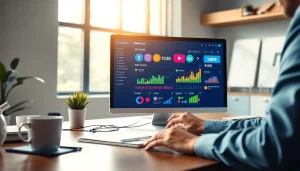Using Competitive Intelligence to Enhance Business Strategy
Understanding Competitive Intelligence
Definition and Importance of Competitive Intelligence
Competitive intelligence refers to the systematic process of gathering, analyzing, and disseminating information about competitors and the overall market environment. According to various industry experts, it plays a vital role in enhancing organizational strategies and decision-making processes. This discipline is not merely about tracking competitors; it encompasses understanding market dynamics, customer behaviors, and emerging trends that could impact an organization’s success. Organizations leveraging competitive intelligence are better equipped to anticipate changes, identify opportunities, and mitigate risks, ultimately leading to improved business performance.
The Role of Competitive Intelligence in Business Strategy
Integrating competitive intelligence into business strategy is crucial for gaining a competitive edge. By continuously monitoring competitor activities and market trends, companies can navigate the complexities of the marketplace more effectively. This proactive approach allows organizations to adjust their strategies in real-time, ensuring they remain relevant and competitive. Moreover, the insights gained from competitive intelligence can lead to innovations in product development, marketing strategies, and customer engagement efforts, fostering a culture of informed decision-making.
Key Components of Effective Competitive Intelligence
Effective competitive intelligence involves several key components:
- Data Collection: Gathering data from various sources, including public records, financial reports, social media, and industry publications.
- Data Analysis: Employing analytical tools and techniques to interpret data accurately and derive actionable insights.
- Dissemination: Sharing the insights across relevant departments to inform strategy and decision-making.
- Ethics and Compliance: Ensuring that competitive intelligence practices adhere to legal and ethical standards to avoid potential pitfalls.
Gathering Competitive Intelligence
Techniques for Data Collection
Gathering competitive intelligence requires a variety of techniques that can be tailored to specific needs and goals. Some effective methods include:
- Surveys and Interviews: Directly engaging customers and industry experts can yield valuable insights regarding preferences and market shifts.
- Market Analysis Reports: Utilizing existing reports from market research firms can provide a clear picture of industry trends and competitor positioning.
- Social Media Monitoring: Analyzing conversations and feedback on social platforms can help identify trends and customer sentiments.
Tools and Resources for Gathering Intelligence
Various tools and resources can aid in effectively gathering competitive intelligence. These include:
- Google Alerts: Set alerts for specific keywords to monitor online mentions of competitors or market-related topics.
- SEMrush: A comprehensive tool for tracking SEO performance, competitor keywords, and ad strategies.
- SimilarWeb: Provides insights into website traffic sources, user engagement, and market share analysis.
Ethical Considerations in Competitive Intelligence
While the gathering of competitive intelligence is essential for informed decision-making, ethical considerations must be a priority. Practices such as industrial espionage or malicious tactics not only violate legal standards but can also damage a company’s reputation. Ethical competitive intelligence should focus on publicly available information and fair practices, ensuring that data is gathered without infringing on privacy or competitive laws.
Analyzing Competitive Intelligence
Methods for Data Analysis
Once data is gathered, the next step involves rigorous analysis to derive meaningful insights. Common methods include:
- SWOT Analysis: Evaluating strengths, weaknesses, opportunities, and threats regarding competitors and market conditions.
- Benchmarking: Comparing performance metrics against industry standards or key competitors to gauge competitive standing.
- Trend Analysis: Identifying patterns over time to predict future market shifts and customer preferences.
Utilizing Insights to Drive Decisions
The true power of competitive intelligence lies in its application. Organizations should create frameworks to integrate insights from competitive analysis into their strategic planning. Implementing decisions based on data-driven insights can lead to improved product offerings, enhanced customer targeting, and greater operational efficiencies. Furthermore, engaging cross-functional teams in strategy discussions ensures that various perspectives are considered, leading to more informed decision-making.
Common Pitfalls to Avoid in Analysis
While analyzing competitive intelligence, organizations should be wary of common pitfalls that can undermine the integrity of their analysis:
- Confirmation Bias: Avoid allowing preconceived notions to skew interpretation of data, leading to poor decisions.
- Lack of Collaboration: Analyzing data in isolation can lead to narrow perspectives; collaborative analysis can foster holistic views.
- Overreliance on Quantitative Data: While numbers are vital, qualitative insights can provide depth and understanding that raw data may not capture.
Implementing Competitive Intelligence
Creating an Actionable Intelligence Plan
To effectively implement competitive intelligence, organizations should develop a detailed action plan that outlines specific objectives, data collection methods, analysis techniques, and dissemination strategies. An actionable plan should also identify key performance indicators (KPIs) to track progress and effectiveness. Regular updates and revisions to the plan ensure it remains relevant in the ever-changing business landscape.
Best Practices for Integration into Business
Integrating competitive intelligence into business practices involves fostering a culture of inquiry and adaptability. Best practices include:
- Training Employees: Equip staff with the skills and knowledge needed to gather and analyze competitive intelligence effectively.
- Cross-Department Collaboration: Encourage various departments to share insights and collaborate on intelligence efforts.
- Continuous Review: Regularly assess the competitive intelligence process to identify areas for improvement and adapt to market changes.
Measuring Success and Impact of Competitive Intelligence
Success in competitive intelligence can be measured through various metrics, including improved market share, customer feedback, and the effectiveness of marketing campaigns. Organizations should regularly review their success against established KPIs, encouraging a proactive approach to adjustment and improvement.
The Future of Competitive Intelligence
Trends and Innovations in Competitive Intelligence
The landscape of competitive intelligence is continually evolving, driven by technological advancements and shifting market dynamics. Emerging trends include the utilization of artificial intelligence (AI) and machine learning to process vast amounts of data efficiently, enabling businesses to remain agile and responsive.
The Role of Technology in Competitive Intelligence
Technology plays an increasingly crucial role in competitive intelligence, particularly through the automation of data collection and analysis. Tools that leverage AI algorithms can reveal insights from unstructured data sources, such as social media and customer reviews, providing a more comprehensive understanding of market sentiment and competitor actions.
Preparing for Changes in Competitive Landscapes
Organizations must remain vigilant and adaptable to thrive in rapidly changing competitive landscapes. By continuously refining their competitive intelligence practices, companies can better anticipate disruptions, seize new opportunities, and mitigate risks effectively. Emphasizing continuous learning and strategic foresight is essential for sustaining competitive advantages in the future.














Post Comment